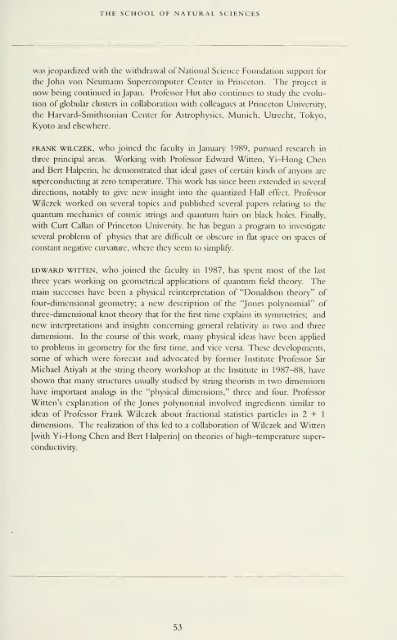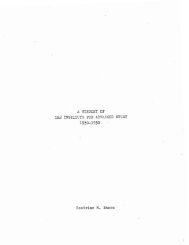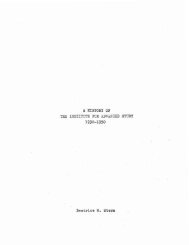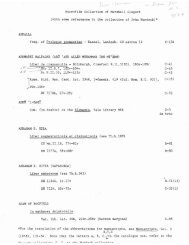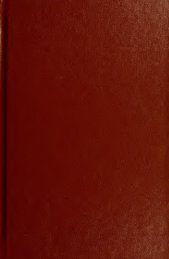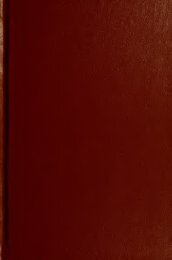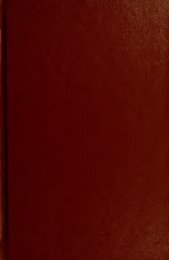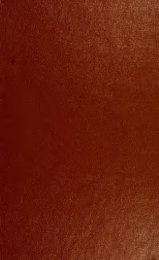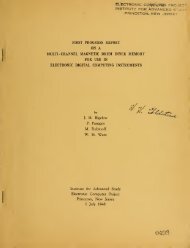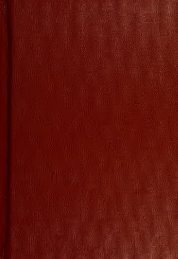Report for the Academic Years 1987-1988 and 1988-1989
Report for the Academic Years 1987-1988 and 1988-1989
Report for the Academic Years 1987-1988 and 1988-1989
Create successful ePaper yourself
Turn your PDF publications into a flip-book with our unique Google optimized e-Paper software.
THE SCHOOL OF NATURAL SCIENCES<br />
was jeopardized with <strong>the</strong> withdrawal of National Science Foundation support <strong>for</strong><br />
<strong>the</strong> John von Neumann Supercomputer Center in Princeton. The project is<br />
now being continued in Japan. Professor Hut also continues to study <strong>the</strong> evolu-<br />
tion of globular clusters in collaboration with colleagues at Princeton University,<br />
<strong>the</strong> Harvard-Smithsonian Center <strong>for</strong> Astrophysics, Munich, Utrecht, Tokyo,<br />
Kyoto <strong>and</strong> elsewhere.<br />
FRANK WILCZEK, who joined <strong>the</strong> faculty in January <strong>1989</strong>, pursued research in<br />
three principal areas. Working with Professor Edward Witten, Yi-Hong Chen<br />
<strong>and</strong> Bert Halperin, he demonstrated that ideal gases of certain kinds of anyons are<br />
superconducting at zero temperature. This work has since been extended in several<br />
directions, notably to give new insight into <strong>the</strong> quantized Hall effect. Professor<br />
Wilczek worked on several topics <strong>and</strong> published several papers relating to <strong>the</strong><br />
quantum mechanics of cosmic strings <strong>and</strong> quantum hairs on black holes. Finally,<br />
with Curt Callan of Princeton University, he has begun a program to investigate<br />
several problems of physics that are difficult or obscure in flat space on spaces of<br />
constant negative curvature, where <strong>the</strong>y seem to simphfy.<br />
EDWARD WITTEN, who joined <strong>the</strong> faculty in <strong>1987</strong>, has spent most of <strong>the</strong> last<br />
three years working on geometrical applications of quantum field <strong>the</strong>ory. The<br />
main successes have been a physical reinterpretation of "Donaldson <strong>the</strong>ory" of<br />
four-dimensional geometry; a new description of <strong>the</strong> "Jones polynomial" of<br />
three-dimensional knot <strong>the</strong>ory that <strong>for</strong> <strong>the</strong> first time explains its symmetries; <strong>and</strong><br />
new interpretations <strong>and</strong> insights concerning general relativity in two <strong>and</strong> three<br />
dimensions. In <strong>the</strong> course of this work, many physical ideas have been applied<br />
to problems in geometry <strong>for</strong> <strong>the</strong> first time, <strong>and</strong> vice versa. These developments,<br />
some of which were <strong>for</strong>ecast <strong>and</strong> advocated by <strong>for</strong>mer Institute Professor Sir<br />
Michael Atiyah at <strong>the</strong> string <strong>the</strong>ory workshop at <strong>the</strong> Institute in <strong>1987</strong>—88, have<br />
shown that many structures usually studied by string <strong>the</strong>orists in two dimensions<br />
have important analogs in <strong>the</strong> "physical dimensions," three <strong>and</strong> four. Professor<br />
Witten's explanation of <strong>the</strong> Jones polynomial involved ingredients similar to<br />
ideas of Professor Frank Wilczek about fractional statistics particles in 2 + 1<br />
dimensions. The realization of this led to a collaboration of Wilczek <strong>and</strong> Witten<br />
[with Yi-Hong Chen <strong>and</strong> Bert Halperin] on <strong>the</strong>ories of high—temperature super-<br />
conductivity.<br />
53


